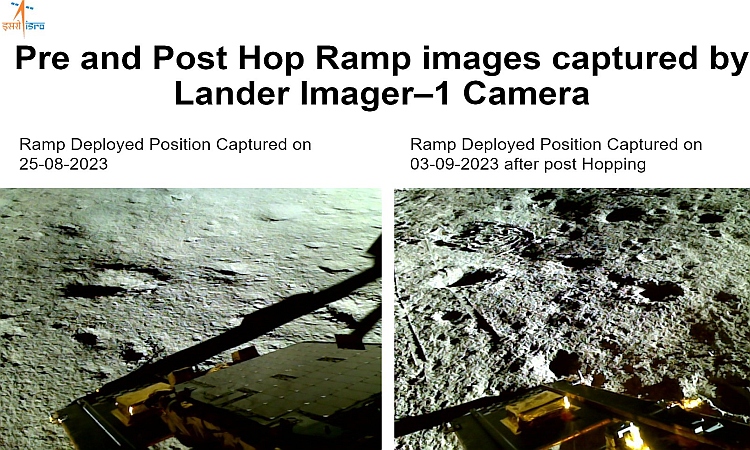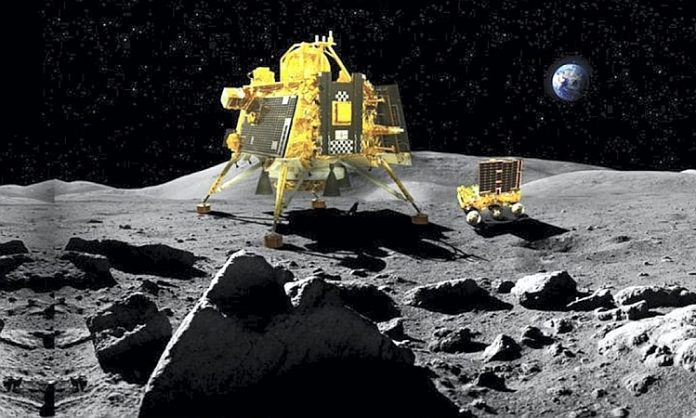Bengaluru: After Pragyan rover, Vikram Lander (parts of moon mission) was also put into ‘sleep mode’ on Monday following a hopping exercise, said the Indian Space Research Organisation (ISRO), hoping for its awakening on 22 September.
In a post on X (formerly Twitter), ISRO wrote, “Vikram Lander is set into sleep mode around 08:00 Hrs. IST today. Prior to that, in-situ experiments by ChaSTE, RAMBHA-LP and ILSA payloads are performed at the new location. The data collected is received at the Earth. Payloads are now switched off. Lander receivers are kept ON.
Also Read: Chandrayaan-3: Day time over; Lander & Rover put in sleep mode
Officials said that the Vikram lander, which connects rover with earth based station, will fall asleep next to Pragyan once the solar power is depleted and the battery is drained. “We hope that both the instrument will wake up once the sunlight hits their panel again on September 22,” he said.
Earlier in a fresh development that may fascinate science enthusiasts, the Vikram Lander, which is currently on the moon’s south pole, successfully underwent a hop experiment. According to ISRO, Vikram elevated itself by about 40 cm and landed safely at a distance of 30-40 cm away on Sunday.

“Vikram Lander exceeded its mission objectives. It successfully underwent a hop experiment. On command, it fired the engines, elevated itself by about 40 cm as expected and landed safely at a distance of 30 – 40 cm away,” ISRO wrote on X.
Why lander’s hopping was important?
Explaining the importance of this event, ISRO said the ‘kick-start’ will enthuse future sample return and human missions on the moon. “All systems performed nominally and are healthy,” ISRO said, adding that the ramp, and lander payloads — ChaSTE and ILSA — folded back and redeployed successfully after the hop experiment. The hop test confirmed ISRO’s ability to ‘kick-start’ the lander once again, days after touching down on the lunar surface.

How was the hop test undertaken?
ISRO said that the payloads and ramp of the lander were folded back before performing the hop test. The spacecraft was elevated by firing its engines and rose up some 1.3 foot into the air before re-landing on the lunar surface at a distance of 30 to 40 cm. “All systems performed nominally and are healthy. Deployed Ramp, ChaSTE and ILSA were folded back and redeployed successfully after the experiment,” ISRO said.
Chandrayaan-3 lander’s landing on Moon
On August 23, India took a giant leap as the Chandrayaan-3 lander module successfully landed on the moon’s South Pole, making it the first country to have achieved the historic feat and bringing to an end the disappointment over the crash landing of the Chandrayaan-2, four years ago. Overall, India became the fourth country – after the US, China, and Russia – to have successfully landed on the moon’s surface.
Also Read: Chandrayaan’s rover finds many chemicals, search for hydrogen on
Since their landing on the southern pole of Moon, the Vikram Lander and the Pragyan rover performed different set tasks on the lunar surface, including finding the presence of sulphur and recording relative temperature. Upon landing, the lander and the rover were to operate for one lunar day. One day on the Moon is equal to 14 days on Earth.
Chandrayaan-3 Mission:
🇮🇳Vikram soft-landed on 🌖, again!Vikram Lander exceeded its mission objectives. It successfully underwent a hop experiment.
On command, it fired the engines, elevated itself by about 40 cm as expected and landed safely at a distance of 30 – 40 cm away.… pic.twitter.com/T63t3MVUvI
— ISRO (@isro) September 4, 2023




